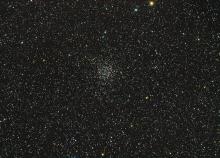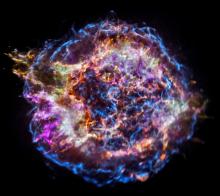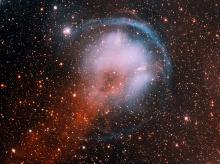Listen to today's episode of StarDate on the web the same day it airs in high-quality streaming audio without any extra ads or announcements. Choose a $8 one-month pass, or listen every day for a year for just $30.
You are here
More Cassiopeia A
An exploded star in Cassiopeia is a huge chemical factory. It’s surrounded by filaments of oxygen, iron, sulfur, and other elements. They were forged inside the star’s core, or in the blast that ripped it apart. Someday, they may be incorporated into new stars, planets — or even living organisms. In fact, the oxygen, iron, and many other elements in our own bodies were created in similar explosions.
Cassiopeia A began life as a heavy star — roughly 15 times the mass of the Sun. The core of such a star is extremely hot. At such high temperatures, it combines lighter atoms to make heavier ones — all the way up to iron.
At the end, the star can’t continue the process. The core collapses to form a neutron star. The star’s outer layers blast into space. The explosion is so hot that it creates many more new elements.
Astronomers have measured the amounts of different elements in the debris around Cas A. The debris forms a bubble that’s 10 light-years wide. It contains enough oxygen to make a star three times as massive as the Sun. There’s enough iron to make 70 thousand Earth-mass planets, and enough silicon to make 20 thousand Earths. All of that material is moving outward at millions of miles per hour — perhaps to form part of a future star system.
Cas A is in Cassiopeia, the queen, which is in the northeast as night falls and wheels high across the north during the night. Its stars form a big letter M or W.
Script by Damond Benningfield






